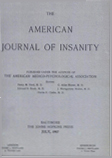THE CLINICAL DIFFERENTIATION OF SENILE AND ARTERIOSCLEROTIC PSYCHOSES
Abstract
The clinical diagnosis of senile and arteriosclerotic psychoses is discussed on the basis of observations in 60 anatomically verified cases.
Senile psychoses tend to occur at a later age and are apt to last longer than arteriosclerotic psychoses. In the former the course was gradually progressive; in the latter a sudden onset was common and the illness was sometimes brief and stormy.
As a rule, intellectual impairment was more pronounced in senile conditions. Acute states of confusion were typical of arteriosclerotic psychoses. Unless their manner of development is known, they cannot always be distinguished from the chronic confused states associated with senile psychoses. Depressive and hypochondriacal-like symptoms were often noted in arteriosclerotic disease; they were seldom a prominent feature of senile disorders. Marked fluctuations in the severity of the intellectual disturbances were common in the former but did not occur in the latter.
Paranoid forms of senile psychosis resembled arteriosclerotic psychoses in that the intellectual functions were usually relatively well preserved, but outspoken and chronic paranoid syndromes were not encountered in arteriosclerotic disease.
Headache, dizziness and apoplectiform phenomena were observed in a considerable number of arteriosclerotic patients, though as a rule permanent neurologic changes did not occur early in the illness. Other characteristic features of this group were syncopal attacks, convulsive seizures, explosive emotional outbursts and clinical indications of cardiac disturbances.
Peripheral (radial) sclerosis was noted with equal frequency in the two psychoses. Hypertension was almost as common in senile patients as in arteriosclerotic patients.
Anatomically pure forms of senile or arteriosclerotic disease occurred less often than mixtures of the two processes, but clinical pictures of a mixed nature were not nearly as frequent as might be anticipated from the anatomic findings.
The mistakes in diagnosis uncovered by anatomic examination are discussed. A diagnosis of senile or arteriosclerotic disease, especially the latter, is made in too many rather than in too few cases. Toxic or symptomatic psychoses are a common source of error.
Access content
To read the fulltext, please use one of the options below to sign in or purchase access.- Personal login
- Institutional Login
- Sign in via OpenAthens
- Register for access
-
Please login/register if you wish to pair your device and check access availability.
Not a subscriber?
PsychiatryOnline subscription options offer access to the DSM-5 library, books, journals, CME, and patient resources. This all-in-one virtual library provides psychiatrists and mental health professionals with key resources for diagnosis, treatment, research, and professional development.
Need more help? PsychiatryOnline Customer Service may be reached by emailing [email protected] or by calling 800-368-5777 (in the U.S.) or 703-907-7322 (outside the U.S.).



